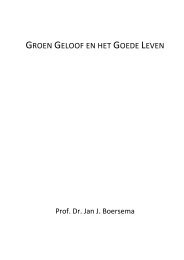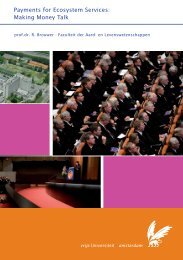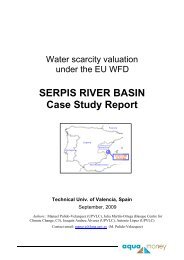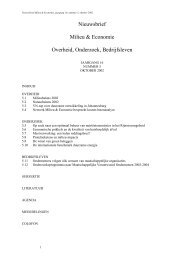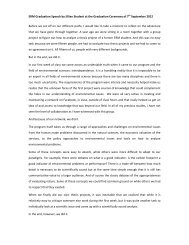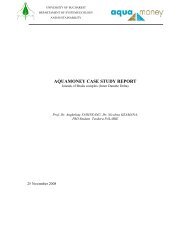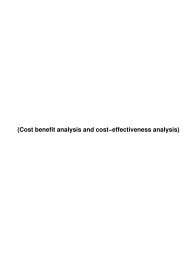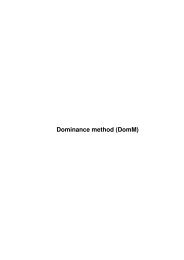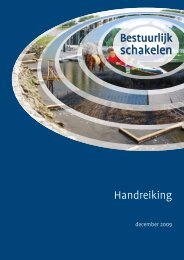Case study report Po Italy - VU University, Institute for Environmental ...
Case study report Po Italy - VU University, Institute for Environmental ...
Case study report Po Italy - VU University, Institute for Environmental ...
You also want an ePaper? Increase the reach of your titles
YUMPU automatically turns print PDFs into web optimized ePapers that Google loves.
AquaMoney<br />
2.2 Water system characteristics<br />
Total water resources in the basin amount at 80 billions of m 3 /year. Water abstraction from surface water bodies is<br />
about 25,1 billion cubic meters per year and 5,3 billion cubic meters from groundwater. A detailed water balance can be<br />
found in <strong>Case</strong> Study Status Report <strong>Po</strong> River Basin (based mainly on in<strong>for</strong>mation drawn from Autorità di Bacino del <strong>Po</strong>,<br />
2006).<br />
The river flows are fed by glaciers on the Alps and by rainfall and groundwater on the Appennines. Lakes have an<br />
important role in particular in Lombardia where the main lakes of the basin are located. Groundwater is an important<br />
source throughout the plain area. Delta length is 25 km and its structure is variable in time and in space. In this area<br />
there are wetlands as the dominant feature.<br />
The river flow is characterised by the important pieces of artificial tracts, <strong>for</strong> about 375 km (from Tanaro to <strong>Po</strong> di<br />
Goro). Some sub-basins are used <strong>for</strong> energy production. Artificial reservoirs along all rivers are exploited <strong>for</strong> several<br />
uses (flood control, etc.). CER canal transports water from the <strong>Po</strong> to the neighbouring Reno basin and Romagna basins,<br />
hence connecting the <strong>Po</strong> with the neighbouring South-Eastern basins.<br />
Urban runoff is unmeasured, but important in drought seasons in some areas <strong>for</strong> irrigation. It goes only partially through<br />
wastewater treatments and can cause water quality problems. Wastewater treatment is compulsory in principle, but is<br />
actually absent or hardly working in many important towns. The hydrographic network is affected by flows from<br />
treatment facilities in Emilia Romagna. A big emphasis is given now to water reuse (through incentive policies), though<br />
it is almost irrelevant in practice. Desalinisation is not relevant.<br />
2.3 Short characterization of water use and water users<br />
Table 1 <strong>report</strong>s the water uses and services in the <strong>Po</strong> basin, divided by sector. The main water using sector is agriculture<br />
(46%), followed by industry (20%) and idropower (18%). The household sector uses only 16% of total water use in the<br />
basin. The distribution among different water uses is very heterogeneous in space. For example, the use <strong>for</strong> energy is<br />
almost totally concentrate in the area of the big lakes (Northern of the <strong>Po</strong> river). In the plain area, agriculture uses the<br />
large majority of the water available.<br />
Table 1: Uses and services of water by sector<br />
Sector Distribution Uses & services<br />
Household 16% Drinking, cooking, washing and other household uses<br />
Industry 20% Manufacturing, thermoelectric cooling and others industrial uses<br />
Agriculture 46% Irrigation of crops, livestock watering, aquaculture<br />
Energy 18% Hydroelectric generation power<br />
Recreation and<br />
Irrigation of parks and golf courses, swimming, boating, maintenance of biodiversity,<br />
-<br />
environment<br />
etc.<br />
Driving <strong>for</strong>ces behind the use by sector show diverging trends. <strong>Po</strong>pulation has decreased in the last years, about -1,5%<br />
each year. In many areas, people move from mountains to urban areas, which gives rise to concentration of human<br />
pressure. At the same time, in other areas population flows from city centres to surrounding settlements. The industry<br />
sector is more or less stable, while the total farms number decreases, but those remained increase their dimension.<br />
Irrigable agricultural area is increasing, while irrigated area is decreasing.<br />
The amount of water used <strong>for</strong> recreation and environmental purposes is partly unknown and partly accounted in the<br />
other sectors. The role of water in maintaining ecosystems and environmental services is very important. <strong>Environmental</strong><br />
flow requirements (EFR) are not well defined in <strong>Italy</strong>. In fact, the decree 152/99 underlines the importance of EFR but<br />
there is not an unique criteria: <strong>for</strong> example, in Lombardia the EFR is taken equal to 10% of annual average natural<br />
capacity (Regione Lombardia, 2005). In general there is a EFR deficit between May and September in Emilia Romagna.<br />
Planning documents provide <strong>for</strong> assuring the EFR in 2008 <strong>for</strong> all basin rivers. Given the weak definition and<br />
uni<strong>for</strong>mity, EFR tends to be an important source of conflicts.<br />
2





